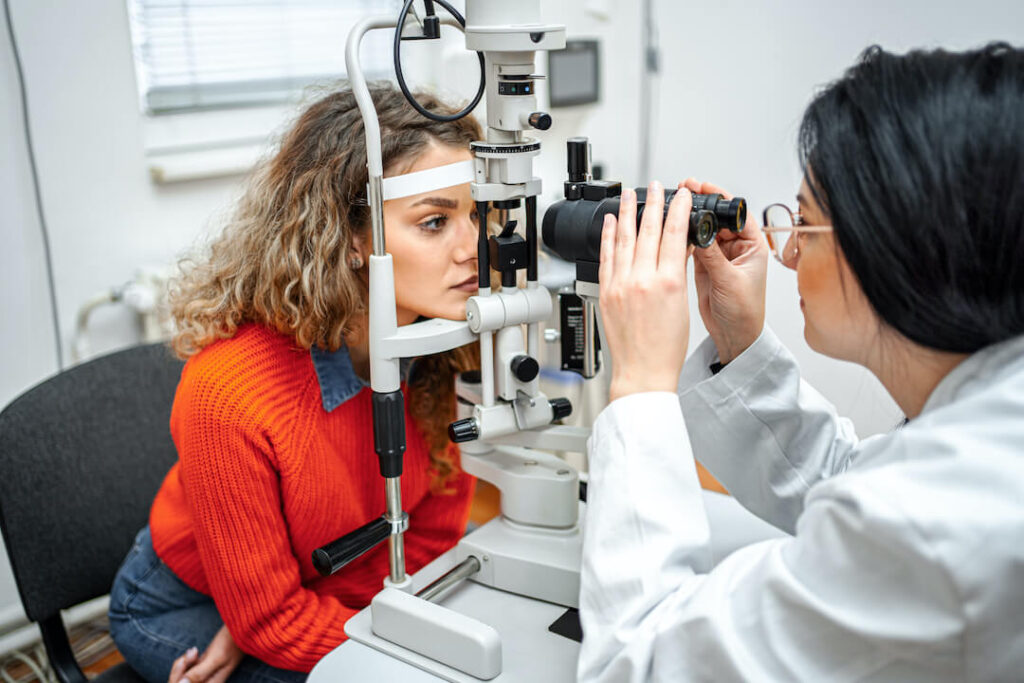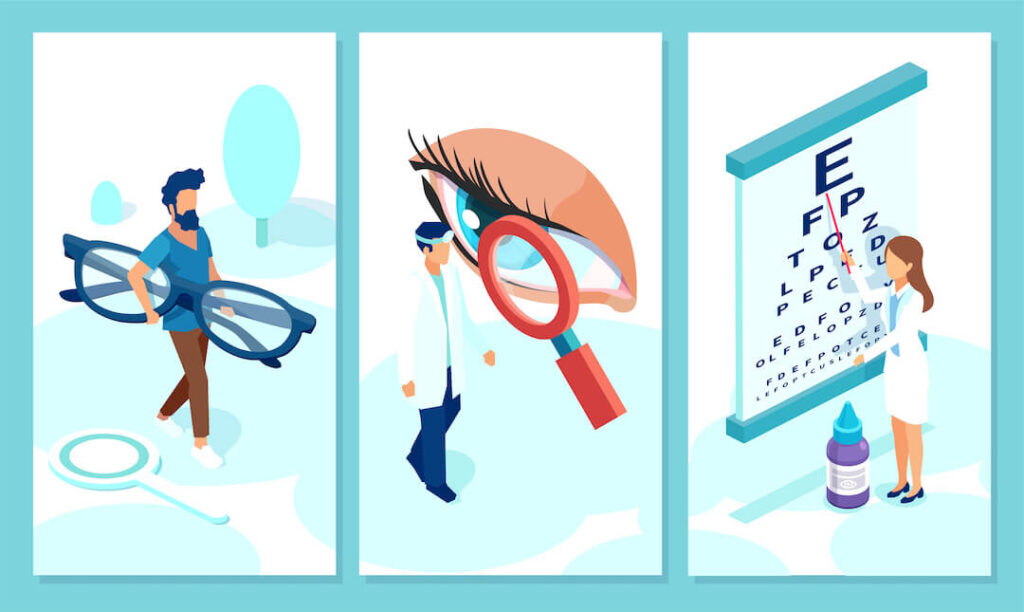Picture this – you’re in the prime of your life, blessed with eagle-eye vision. You could spot a fly on a tree trunk from across the park! So, do I need vision insurance if I have good vision? Isn’t it just an unnecessary expense?
A few years back, my friend Ben thought so, too. He enjoyed perfect eyesight and considered himself immune to any future eye issues. But one routine check-up changed everything.
This is where our story begins – but trust me when I say that’s not where it ends.
Whether or not we wear eyeglasses today isn’t really what matters here because ensuring our peepers stay healthy involves much more than meets the eye!
We’ll explore the hidden costs of skipping regular eye check-ups and suggest preventive steps for catching problems early.
Table of Contents
Understanding the Importance of Vision Insurance

Vision insurance is more than just a benefit to provide vision insurance for those with poor eyesight. It’s about protecting your eye health and catching vision problems early. Even if you have a good vision now, things can change.
The importance of having a vision insurance plan goes beyond getting help to pay for eyeglasses or contact lenses. These vision insurance plans also cover routine eye exams vital in detecting potential issues like glaucoma or cataracts before they worsen over time.
Vision insurance covers costs for preventive eye care providers and prescription eyewear. Regular check-ups with an eye doctor allow professionals to catch symptoms that might indicate underlying conditions affecting your sight and overall health.
You may believe you don’t require vision insurance as your eyesight is perfect. But remember this: Many serious eye diseases do not show noticeable symptoms until they’re quite advanced.
Routine Eye Exams: More Than Just Testing Your Sight
Your annual visit isn’t simply about reading letters off a chart across the room. A comprehensive eye exam involves several tests designed to evaluate every aspect of your visual system – from assessing how well each eye works together, checking peripheral (side) vision, looking at color perception abilities, and testing depth perception.
The Hidden Costs
Sure, glasses look cool these days. But without proper coverage, even basic frames paired with corrective lenses could cost you hundreds of dollars out-of-pocket. Add extras like scratch-resistant coating or transition lenses; we’re talking about some serious cash.
This doesn’t even take into account the cost of regular eye exams. Without vision insurance, the average cost of an annual eye exam is around $95.
Thinking Long Term: Eye Health and Your Future
Even if you’re not squinting to see road signs or struggling with small print now, our eyes naturally change as we age. It’s worth considering how much potential vision issues could impact your life down the line.
access eye care when you need it. This coverage gives you the confidence to prioritize your vision health without worrying about the costs.
Key Takeaway:
Even with good vision, getting vision insurance is a smart move. It’s not just about glasses or contacts – it’s also about safeguarding your eye health and catching potential issues early on. Regular check-ups can help spot signs of serious diseases before they get worse. And let’s not forget that stylish eyewear often comes with hefty price tags. Without the right coverage, you might find yourself facing significant costs.
The Comprehensive Coverage of Vision Insurance

Ever wondered about the broad spectrum of services covered by most vision insurance plans? Let’s shed some light on it. Generally, a typical vision insurance plan will help with routine eye care and prescription eyewear costs.
Routine Eye Care
To start off, let’s focus on how important regular eye exams are for maintaining your peepers’ health. With good vision insurance coverage, these critical check-ups become more affordable.
Catching potential issues early is like being a superhero – spotting problems before they blow up. That’s why comprehensive eye exams are vital even if you have 20/20 vision because diseases like glaucoma can creep in without any warning signs.
Vision plans often cover an annual or bi-annual exam where an optometrist assesses your visual acuity and general ocular health. This preventive approach safeguards against vision loss and provides early detection for systemic conditions such as diabetes or hypertension that may manifest first in the eyes.
Prescription Eyewear
Moving onto prescription eyewear – glasses and contact lenses don’t come cheap. But guess what? Vision insurance has you covered here, too.
A standard policy generally includes allowances towards frames and lenses once every year or two years, depending upon the plan specifics. For those who prefer contacts over specs, there might be options available providing benefits toward lens purchases instead of glasses.
But wait…there’s more. Some plans offer sweet deals for specialty options such as anti-glare coatings or high-index materials at discounted rates. It gets even better when considering elective vision correction surgery, with certain plans providing substantial discounts on procedures like LASIK and photorefractive keratectomy.
All in all, vision insurance proves to be a good friend for your eyes. It offers coverage that can keep those windows to the soul clear and healthy, ensuring you don’t miss out on any of life’s beautiful views.
What's Not Covered by Vision Insurance?
It’s crucial to know that while vision insurance offers significant help with costs related to eye care, it doesn’t cover everything. The limitations of vision insurance can sometimes surprise policyholders.
Vision plans often don’t include additional eye exams outside the routine preventive ones or replacement of damaged or lost eyeglasses and contact lenses. If you tend to mislay your specs, it may be something you’ll have to plan for independently.
Choosing the best vision plan involves understanding these gaps in coverage and deciding how important they are for your specific situation. For example, some people might find it essential to always have a backup pair of glasses handy, just in case.
The Grey Areas
Beyond these clear-cut exclusions, there are also grey areas where insurance coverage varies. Some non-covered items in vision insurance may fall under general health insurance instead – think of treatments for severe conditions like cataracts or glaucoma.
This is why deciding about vision insurance costs isn’t as simple as comparing monthly premiums alone; you’ll also want to consider what each policy covers.
Cosmetic Enhancements and More
Lastly, cosmetic enhancements such as tinted lenses or designer frames usually aren’t covered either. The same goes for elective procedures like photorefractive keratectomy (PRK) and laser-assisted in situ keratomileusis (LASIK).
While these procedures can drastically improve vision and even eliminate the need for glasses or contacts, they’re often considered non-essential and thus aren’t covered by most plans.
A Matter of Balance
In conclusion, understanding what isn’t included in your plan is as important as knowing what is. You may have good vision now, but eye health can change over time. Regular eye exams help catch potential problems early, while insurance coverage helps manage costs associated with maintaining optimal sight.
You’ll want to balance out these factors when considering whether a specific vision insurance policy makes sense for you.
Key Takeaway:
It’s important to note that while vision insurance can certainly help manage your eye care costs, it doesn’t cover everything. Many vision insurance plans may not cover additional exams, replacement glasses, or contacts – the same goes for cosmetic enhancements and elective procedures like LASIK. Understanding these coverage gaps before choosing a plan is crucial since insurers vary in their offer. Remember, maintaining good sight isn’t just about having insurance—it’s also about finding the right balance with what your policy covers.
The Cost-Benefit Analysis of Having Vision Insurance

Crunching numbers is a crucial part when it comes to choosing an insurance plan. Comparing the costs of eye care services without insurance to those with coverage, let’s analyze the benefits of vision insurance.
The cost of a sight exam, not covered by insurance, can be quite high – usually around ninety-five dollars. That might not sound like much initially, but add in prescription lenses or contact lenses, and that number can skyrocket quickly.
Vision plans often cover routine eye exams and provide discounts on eyeglass frames and lenses. Some even offer discounted rates on elective vision correction surgery such as LASIK or photorefractive keratectomy (PRK).
In comparison, monthly premiums for most vision insurance range from just $5 to $15. They are designed to help reduce out-of-pocket expenses by covering a significant portion of preventative routine eye care and offering substantial savings on other procedures and materials.
- An annual comprehensive eye exam – check.
- A pair of stylish eyeglass frames – discount granted.
- Contact lens fitting – yes, please.
You’ll notice that these benefits could lead to substantial savings over time, especially if you need corrective lenses or have potential risks for certain types of eye diseases requiring regular follow-ups.
This isn’t only about dollars saved, though; there’s also value in catching any possible issues early before they become major problems, leading potentially to severe vision loss. Regularly scheduled exams covered by your policy may detect signs earlier than one-off visits paid fully from pocket.
So, when weighing the cost of vision insurance against its benefits, consider financial and health aspects. While everyone’s situation is unique, some foresight could save your pennies and sight.
Remember: Cost isn’t everything; it’s about value. Think carefully about what’s included in any plan before deciding if it provides enough cover to see clearly into the future.
Key Takeaway:
When considering vision insurance, it’s more than just number crunching. Sure, monthly premiums of $5-$15 may save you on eye exams and glasses, but think about the value beyond dollars – catching potential issues early to prevent severe vision loss. Remember: It’s not just cost; it’s also seeing clearly into your future.
Vision Insurance for Individuals with Good Vision
Having good vision might make you question the need for vision insurance. But, it’s essential to consider factors beyond your current eye health.
Even if you’re blessed with 20/20 vision today, routine eye care is still crucial. Regular eye exams can detect potential problems, like glaucoma or macular degeneration before they become more serious. Besides, a regular check-up helps maintain optimal visual health by catching any changes in your eyesight and adjusting corrective measures accordingly.
The Benefits of Regular Eye Exams
Eye doctors do much more than merely determine your prescription for eyeglasses or contact lenses during an annual eye exam. They also check your eyes for common diseases, assess how well your eyes work together as a team, and evaluate them as indicators of overall health.
An annual visit to the optometrist isn’t only about ensuring perfect sight; it’s about safeguarding against possible future conditions that could affect our ability to see and our general well-being.
Coverage Provided by Vision Plans
Vision insurance plans generally cover routine preventive care such as comprehensive eye exams and discounts on corrective eyewear (glasses or contact lenses). The national average cost for an annual exam is around $95 without coverage – quite a significant amount when considering out-of-pocket costs over several years.
If you require glasses or contacts even infrequently due to slight changes in prescriptions over time – having this kind of insurance will help cut these costs substantially. Vision insurance costs and benefits guide.
Insurance for Potential Future Needs
Another point to ponder is your future eye care needs. Vision problems can and do develop over time, often without symptoms in their early stages. Conditions like presbyopia or cataracts are common as we age.
No matter your current vision, you may require glasses in the future.
Key Takeaway: Even with good vision, don’t overlook the benefits of regular eye exams and potential savings from a vision insurance plan. Eye check-ups detect issues early, maintain visual health, and safeguard against future conditions. With costs like $95 for an exam or pricey corrective eyewear, coverage can help lighten your wallet’s load.
Understanding Different Types of Vision Insurance Plans
Different vision insurance plans offer a variety of coverage options, with each designed to cater to unique needs. Whether you require regular eye exams or a parent considering eyewear for your children, understanding how vision insurance works and the benefits and costs associated with these plans is crucial.
Monthly Premiums
The cost of vision insurance is worth maintaining good eye health, so it shouldn’t be a burden on your wallet. With an average monthly premium, often around $5-$15 per month, according to Humana, vision insurance makes it affordable to care for your eyes regularly.
Premiums may differ depending on age, area, and inclusion. For instance, comprehensive vision insurance plans tend to have higher premiums but cover more services like routine preventive care and prescription lenses than basic ones.
Vision Discount Plans vs. Insurance Coverage
Apart from standard vision insurance plans covering costs after paying deductibles or copayments, some vision discount plan programs give members access to discounted prices at select providers. These might not provide full coverage but can help reduce out-of-pocket expenses significantly if used wisely.
Besides offering discounts on frames and contact lens purchases in the network alone, some programs even include reduced rates for elective procedures like photorefractive keratectomy (PRK) or laser in situ keratomileusis (LASIK).
Selecting Your Plan: Factors To Consider
In choosing between different types of policies available in the market today – whether they are traditional indemnity-type policies that allow you a choice among all participating optometrists/ophthalmologists or managed care vision plans that require you to select from a network of providers – there are certain factors you should consider.
For example, suppose you wear eyeglasses or contact lenses regularly and want coverage for routine eye exams and replacement glasses/lenses. In that case, an insurance plan might be more suitable. On the other hand, those with good vision who don’t anticipate needing much beyond annual check-ups could opt for discount programs instead.
your most important senses. Knowing about various vision insurance plans helps you make informed decisions and get vision insurance now, ensuring the best eye protection.
Key Takeaway: Choosing the right one is crucial with various vision insurance plans. The monthly premiums are usually easy on your pocket, which makes routine eye care less financially stressful. Discount programs give you slashed prices on some services and products instead of full coverage. When choosing, consider how often you need new eyewear or check-ups.
Making an Informed Decision About Vision Insurance
Choosing whether to invest in vision insurance can be a tricky task. But with the right knowledge, it becomes easier.
Coverage for Family Members
Adding family members to your plan can help you find vision insurance and save on eye care costs. Babies should have their first vision screening within the first year. Regular exams become essential in detecting potential issues early as they grow.
Vision insurance plans often include coverage for annual eye exams and eyeglass frames. The savings from these benefits alone could offset the cost of monthly vision insurance premiums if you or your kids wear glasses or contact lenses.
Ophthalmologist Care
If serious eye health issues arise, health and vision insurance might cover visits to an ophthalmologist. It’s crucial because these professionals are equipped to handle more complex conditions beyond routine preventive care provided by optometrists.
Unexpected issues, like blurred sight or frequent headaches, may come up without warning, which could be signs of underlying conditions needing urgent attention, such as glaucoma or macular degeneration.
In conclusion, deciding on getting vision insurance depends on various factors, including personal needs and circumstances, but don’t overlook its value even if you have good eyesight today. Remember: prevention is better than cure.
FAQs: Do I Need Vision Insurance if I Have Good Vision
What are the disadvantages of vision insurance?
Vision insurance may not be cost-effective if you have minimal eye care needs. It typically, employers offer vision insurance that can’t cover all services or eyewear, and some policies have waiting periods.
What is the difference between a vision plan and vision insurance?
A vision plan offers discounts on specific services or products. Vision insurance, however, covers part of your costs for routine check-ups and prescription eyewear.
Is vision insurance required in the US?
Nope, it’s optional. However, having coverage can help manage expenses related to regular eye exams and prescription glasses or contacts.
Now that you have considered the query, “Do I need vision insurance if I have good vision?” you can make an informed decision.
You’ve seen how regular eye exams are more than just a check-up. They’re your early warning system against potential problems. Eye diseases can creep in silently; catching them early is crucial.
We’ve also highlighted how cost-effective having a vision plan can be when compared with out-of-pocket expenses. Yes, even if you don’t require glasses or contact lenses!
You learned about what typical plans cover – from prescription eyewear to treatments for certain eye conditions.
Lastly, we explored alternative options like employer-provided benefits or health savings accounts, which could be viable substitutes based on your needs.

